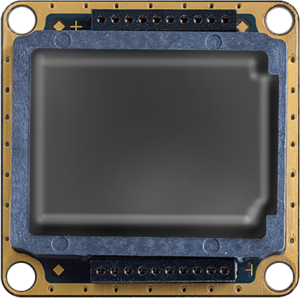Home » Resources » Case Studies » Infrared Camera Image Pre-Processor

The primary objective for this project was to miniaturize an image pre-processing module to a targeted size of less than 1.0 sq in. that would connect to an IR camera system. Packing multiple bare die and components, plus interconnect, into a miniatured package presents many challenges, but ISI has the in-house talent and resources to develop and prototype a design optimized for manufacturing in our U.S.-based, ITAR-compliant facility.
Main objectives:
Originally, the customer approached ISI as they were seeking a contract manufacturer to produce a design they were developing in-house. At this stage, the customer delivered a design that was near completion and to be evaluated by ISI engineers. Based on the current design status and defined specifications of the project, ISI conducted an in-depth review of the customer’s proposed design and discovered a lot of issues that would need to be addressed as the project further developed.

Module shown prior to encapsulation
After an in-depth design review and consultation with ISI’s engineering team, multiple approaches were analyzed to propose the best commercially viable solution that fully met all key requirements. When the customer agreed to our proposed solution we divided responsibilities entering into the next phase of development to begin detailed work on the many components to the overall design.
With technical guidance from our PCB designers, the customer performed recommended redesign work to the board. Meanwhile, our in-house development team worked in sync to coordinate design and production of customized interconnect and molded frame. The customer provided solid models, as the module will be incorporated into a sub-system containing a camera and other electronic components.

3D model, module top-side

3D model, module bottom-side
Our customer brought a near-complete design that had a lot of problems. The design had issues with improper wire bond placement and an inefficient “pedestal heatsink” that unnecessarily took up a lot of physical space in the overall design. We recommended changes to simplify the design and to better address thermal dissipation, specifically by splitting the assembly into two and interconnecting them with a custom-designed a HiLo connector and molded frame, both of which were designed and manufactured in-house. Special attention was focused on providing guidance and support to the customer to incorporate efficiencies to optimize for manufacturability at our production facilities.
This project was accomplished in 12 weeks total, which included the substrate build. ISI’s in-house capabilities allowed us to significantly shorten lead times for the HiLo connector and the molded frame. Our ability to codevelop with the customer and perform in-house manufacturing saved roughly 6 weeks of additional turnaround time as compared to working with a traditional contract manufacturing vendor. ISI delivered value in time-savings and in providing highly technical expertise to deliver a fully tested and functional finished product.

Working with the ISI team is a highly collaborative engagement. The initial requirements customers bring are the starting point, but the big benefit comes as our engineers work to propose various solutions, including pros and cons of each. Those solutions include what many competitors can’t offer, which is in-house execution of nearly all aspects of the project.
Exchange technical details with customer to define challenges and establish scope of the project.
Assess likelihood of achieving the desired outcome and estimate the required engineering effort.
A quote will be issued to include NRE charges, price for prototypes and production volumes, and timeline for completion.
Design work begins with a particular focus on manufacturability. Frequent technical exchanges with the customer ensure a design that meets their expectations.
Upon customer approval, ISI initiates orders with suppliers and starts developing tools, molds, fixtures, and other custom equipment as required.
After satisfactory prototype testing and customer approval, product is released for volume production.
Your message will go to our in-house technical sales team. We typically get back within one business day.